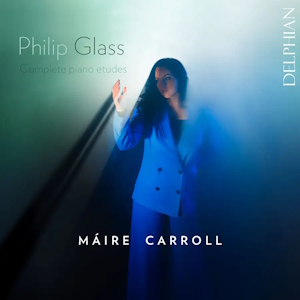
Philip Glass (b. 1937)
Complete Etudes for piano (1994-2012)
Máire Carroll (piano)
rec. 2023, St. Peter’s Church, Drogheda, Ireland
Delphian DCD34330 [2 CDs: 125]
I doubt there is any other contemporary music that has racked up as many recordings as the two books of Etudes by Philip Glass. To the best of my knowledge, there are at least ten complete recordings, and at least as many with a selection from the twenty individual pieces. My introduction to them was courtesy of the Icelandic pianist Víkingur Ólafsson, whose album of Glass piano works is one of my most played. The energy, dynamism, poetry and clarity makes his readings of a selection of the Glass Etudes unmatchable in my eyes (or should that be ears?).
I have opted to base this review on five of the Etudes, comparing Carroll’s readings, not to those of Ólafsson – because I feel that would be unfair given my thoughts on his performances – but to those from two other complete sets, Jenny Lim (Steinway & Sons) and Maciej Gański (Dux – review), chosen in part because their total time was similar to Carroll’s. The five Etudes I have chosen for my comparison are Numbers 2, 5, 6, 15 and 18, picked mainly because they are among my favourites.
If you are reading this review, you will probably be aware of the background to the works, but I will mention it anyway. The twenty were composed individually and published as two books of ten, with the first book intended by the composer as exercises (as the name implies) to improve his own piano skills. The second book is more pianistically and compositionally ambitious, Glass intending the pieces for pianists more able than he.
Number 2 opens gently, with alternating bars of 7/8 and 4/4, imparting an unsteadiness. The volume gradually builds, as does a sense of anxiety. Carroll is markedly slower than my two comparisons, at 7:38 (Lin 6:32 and Gański 5:47), and the languorous tempo smooths out the rocking motion of the alternating time signatures, robbing it of some of its appeal. Lin’s opening really plays up the bar-by-bar variation, while Gański’s, clearly quicker, still shows the effect but not quite so clearly (in my review, I praised Gański’s take on this Etude highly, but twelve months on, I’m not quite as impressed). As the intensity level rises, Lin and Gański continue to impress, but sadly Carroll sounds pedestrian and in places a little clunky.
Number 5 is hypnotic (even for Glass), eerie and haunting. Here Carroll’s tempo puts her firmly in the middle, with Lin much faster and Gański much, much slower (8:08 – 9:02 – 11.15). This time her approach works far better than the other two. Gański stretches the thread of melody out too far, while Lin seems to overemphasise the pauses. This is one of the best of Carroll’s set. It also sounds quite beautiful: rich and round.
Number 6 is hard driven throughout, with the insistent rhythms punctuated by recurring surges of volume. Gański is about thirty seconds faster than Carroll and Lin, though the difference isn’t especially apparent while listening. Indeed, Lin sounds faster despite being slowest (I don’t think this is the consequence of repeats taken or not). Carroll provides the least variety in dynamics of the three, perhaps following the score’s direction of mf more closely, but in doing so, diminishing the drama and excitement, and ultimately a little disappointing.
It was at this point that I became concerned that I was not doing Máire Carroll any favours with the Etudes I had chosen. Fortunately in the remaining two, she shines. Number 15 has real Romantic grandeur, and Carroll gives that full rein. By contrast with the other comparisons, there is little to distinguish the three performances in approach and timing here, but I think the richness of Carroll’s piano might win out. Number 18 is another hypnotic and haunting one, cut very much from the same cloth as the soundtrack to The Hours. Here Carroll is considerably slower than Lin and Gański, to her advantage as it instils a greater degree of poetry.
I have mentioned a couple of times the rich glow that the recording has given Carroll. In some of Philip Glass’s music, especially the earlier pieces, this would not be necessarily suitable, but here it works very well. The informative booklet notes describe Carroll’s approach to the Etudes as adhering “more closely and accurately to Glass’s original tempo markings and dynamic indications” than certain other pianists (one suspects Ólafsson might be included here). On the surface, not tampering with the composer’s intentions might seem a good thing, but in places it has made the pieces seem a little mundane, and no more than practice works, when Ólafsson has shown that they can be concert hall stars. However, elsewhere across the two books, especially the slower, more emotive pieces, Carroll’s poetic playing stands out.
I intend to work my way through some of the other complete sets of Etudes, and based on what I have heard so far, there is likely to be no perfect one. Máire Carroll’s has definite charms, and very different to those of Gański’s set, but perhaps my main takeaway from this review is that my next stop will be to listen to all twenty of Lin’s.
David Barker
Previous review: Stephen Barber (November 2024)
Buying this recording via a link below generates revenue for MWI, which helps the site remain free



















